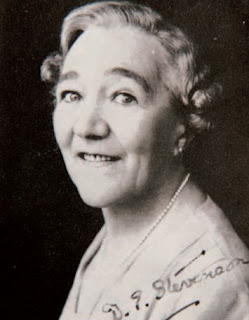The Cotswold village is not the liveliest place but does have a dramatic club, to which Delia belongs. When a lovely young widow comes to town and joins the dramatic club, she causes a stir, and Delia is excited to have made a sophisticated friend (although it is clear to the reader Delia is merely tolerated). She is jealous of Meg’s happy marriage and somewhat contemptuous of her younger sister, Rose, who is sweet and overly trusting. Three years after his father’s death, Walter reappears, truly penitent for the pain he caused and willing to help his stepmother financially.
Margaret was looking very thoughtful and Walter wondered what was coming next. At last she said, “You’ll stay to lunch, won’t you? I was just wondering if there would be enough, but it will be all right. You’ll stay, won’t you, Walter?”The dramatic club is putting on The Mulberry Coach by Jane Harcourt, who was the youngest of three sisters in a book I reviewed recently, Anna and Her Daughters (and as in this book, the eldest sister is unpleasant, which we eldest sisters disapprove of). Stevenson’s books are full of what we now call Easter eggs and some of her fans created a wonderful chart of the connections and recurring characters as it is difficult to keep track otherwise but great fun to notice.
He could not help smiling. “Well, if you’re sure it won’t be a bother . . .”
“No bother at all – and I promise there will be enough to eat. Bernard is coming home to lunch, so you’ll see him,” added Bernard’s wife , offering the bait with confidence. Obviously, she was of the opinion that no fish could resist it.
“Yes, I’d like to meet Bernard,” said the fish.
The Fair Miss Fortune (2011)
When Jane Fortune moves to Dingleford Cottage with her old nurse as chaperone, with the goal of opening a tea shop (this happens a lot in fiction, although I always assume in real life they would not be able to make an adequate living). She is welcomed to town by two young men who like her immediately. Charles Weatherby is a military man, home from India on leave, visiting his widowed mother, who is very sweet and understands him much better than he realizes. Charles’ childhood friend, Harold Prestcott, is a kindhearted young man but completely henpecked by his unpleasant mother, who does not approve of his being interested in any young lady. The two mothers have nothing in common but pretend to be cordial to one another.Charles is mistaken for a plumber when he meets Jane; the misunderstanding helps him overcome his diffidence and he is smitten at once. However, Harold also becomes enamored and it seems as if Jane is encouraging both men although she is clearly Not That Sort of Girl, so the men, when they believe they are rivals, are very perplexed. The mystery has a logical explanation, of course, and everyone lives happily ever after, although I don’t think Nannie is going to want to go live in India.
This book was not published during Stevenson’s lifetime as her publisher thought it was too old-fashioned, which is funny because all her books are old-fashioned and no one objects to them! It is charming, and full of Stevenson's humor and quirky characters who do not know how amusing or snide they are. In a way, it is little P.G. Wodehouse-like with mistaken identity, some bucolic humor, and characters not fully developed. My criticism is that it is very slight but Stevenson offered to lengthen it. When that offer was rejected, she put it away and went on to the next project but it was finally published by Greyladies in 2011 and has now been added to the Furrowed Middlebrow collection with an appealing cover. The correspondence between DES and her agent discussing the initial rejection of the novel by her publishers is included in the book.
 |
| Don't you see a twinkle in her eye?! |




I loved The Fair Miss Fortune, and I agree, there are a lot of tea shops in books of the period, aren't there. I know at library school on my management course we found that a coffee shop in a library was a good earner, so maybe there's something in it ... I have had a couple of the other Stevensons and some of the earlier Molly Claverings for Christmas and birthday presents, as well as receiving two review copies, so I'm doing well and really looking forward to wallowing in them!
ReplyDeleteI really like D.E. Stevenson and always look forward to reading more of her books. Fair Miss Fortune looks especially fun.
ReplyDeleteI went and checked out the new D. E. Stevenson books at Furrowed Middlebrow and they all look good.
ReplyDeleteOf the two you reviewed above, I am definitely interested in The Musgraves, and possibly also the Fair Miss Fortune.
I loved The Fair Miss Fortune too and the other D.E. Stevensons I've read, although it's not that many. I must see about getting more from Dean Street Press as they're lovely editions, keep seeing them all over Twitter!
ReplyDeleteWonderful post. Aren't we so lucky that DSP is in the world!
ReplyDeleteA lovely post! I'm participating in the Back to the Classics challenge this year, and just realized that some of the DE Stevenson books may actually fit in with the prompts. (I am assuming these were written prior to the cut-off year of 1972.)
ReplyDelete